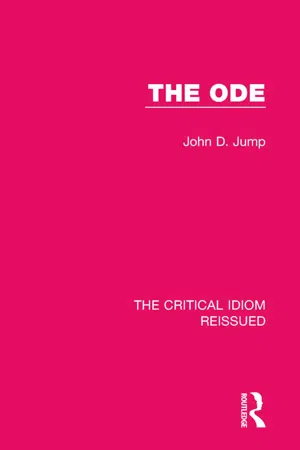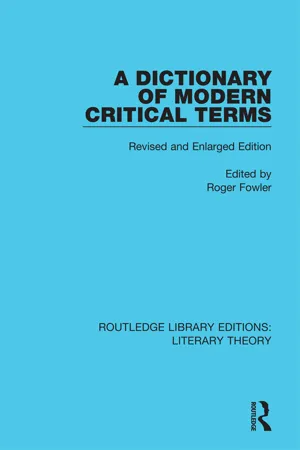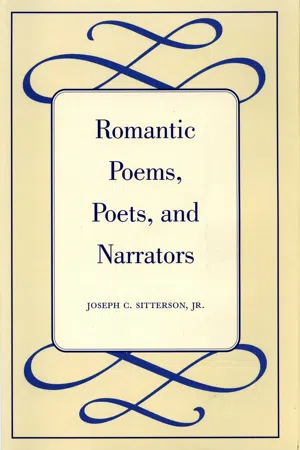Ode
An ode is a type of lyrical poem that expresses deep feelings of admiration, love, or respect for a person, event, or object. It often has a formal structure and elevated language, and is characterized by its celebratory and exalted tone. Odes have been a popular form of expression in literature, with famous examples including John Keats' "Ode to a Nightingale" and Pablo Neruda's "Ode to My Socks."
4 Key excerpts on "Ode"
...4 Nineteenth-Century Odes The examples we have considered so far allow us to think of an Ode as a poem of a grave and noble kind on a theme of acknowledged importance; it is likely to be of fair length, and either cast in the form of an address or evoked by some particular occasion. Naturally, individual specimens may deviate appreciably from this general account, and a poem as light and as brief as that in which Prior describes his involvement with the rival ladies may receive the title. Though we should find certain poems difficult to classify, we can make a general distinction between an Ode and a song. Etymology gives no help here, since ‘Ode’ is itself a Greek word meaning ‘song’ that has come to us through the Latin ‘oda’. But our actual usage shows that we think of a song as comparatively simple and spontaneous and of an Ode as comparatively elaborate and formal. These attributes of the Ode need not imply any lack of emotion. On the contrary, many Odes are characterized by serious reflection upon feelings of very great strength. It is with some such general account in mind that we must approach the Odes of a period in which the Pindaric and Horatian traditions become much less clear and distinct. No doubt Odes in both traditional styles were still appearing. But they rarely came from poets of the rank that alone concerns us here. Such poets might write irregular Odes and they might write formal Odes. But they were unlikely to be thinking of Pindar or Horace in connection with them. Admittedly, things were different on the Continent. Goethe and Schiller in Germany and Victor Hugo in France produced Odes in the Pindaric tradition, and Holderlin was the most ardent Pindarist of all. But in England the irregular Ode and the formal Ode had by this time achieved effective independence of the Classical authors to whom they owed their conception...
- eBook - ePub
A Dictionary of Modern Critical Terms
Revised and Enlarged Edition
- Roger Fowler, Roger Fowler(Authors)
- 2016(Publication Date)
- Routledge(Publisher)
...For two comprehensive and opposing views of the problem see: J. Press, The Chequered Shade (1958); J. Sparrow, Sense and Poetry (1934); see also G. Steiner, ‘On difficulty’ in his On Difficulty and Other Essays (1978). CS Ode In English, a much-practised form of lyric poetry from the time of Ben Jonson to that of Tennyson, with sporadic mOdern revivals. The most elevated and complicated species of lyric, the Ode was often written to celebrate notable public occasions or lofty universal themes. It attracted an exalted diction and free metrical experimentation, highly formalized stanza-types rather removed from the main currents of English versification. The exponents of this genre were usually explicitly conscious of their classical mOdels, hence the strangeness of the verse forms: many poets attempted to render in English metrical patterns which were natural only in terms of the sound-structure of Greek. The classical mOdels are Pindar (522–442? B.C.) in Greek and Horace (65–8 B.C.) in Latin. Although Horace was much more familiar to the English, the Pindaric Ode interested poets more, because it was metrically highly distinctive. Pindar’s Odes (derived from choral lyrics in drama) were composed to be chanted to music by a dancing chorus. The demands of music and dance resulted in a highly elaborate stanzaic structure: this type of Ode was built on a sequence of sections called strophe, antistrophe and epOde, the sections constructed from lines of varying length. Such a complicated verse-form provided a stimulating challenge to English metrists. The Pindaric Ode was ‘occasional’, that is to say, composed for a specific and important public event (e.g. to honour the victors in Greek athletic games). The Horatian Ode, though sometimes public, was frequently personal and reflective. It shared the solemnity and dignity of the Pindaric Ode, but was less of a metrist’s virtuoso-piece...
...In Sketches of a History of Literature (1794), Richard Alves concludes his discussion of recent lyric poets by declaring that ‘no species of poetry is more worthy of notice, and, in no age whatsoever, was lyric poetry cultivated to more advantage’ (Patey 1993:589). This picture of a golden age is strongly challenged by others, however: lyric is often perceived as a minor literary form, and there is deep suspicion about the contrived expression of feelings in love poems and elegies. Amatory and elegiac verse, sonnets and epigrams are dismissed by Rapin in his Reflections on Aristotle ’ s Treatise of Poesie (1694) as ‘the meer productions of Imagination’, while Temple, in ‘Of Poetry’ (1690) argues that those who cannot write successful heroic poetry must be satisfied with ‘the Scraps, with Songs and Sonnets, with Odes and Elegies’ (Abrams 1953:85). In his 1756 study of Pope, Joseph Warton portrays the mOdern Ode as a poor imitation of its ancient predecessor: ‘The mOderns have, perhaps, practised no species of poetry with so little success, and with such indisputable inferiority to the ancients, as the Ode’ (Patey 1993:588). As the next chapter argues, the Romantic period later privileges the Ode as a poetic form. Lyric undergoes a more fundamental attack in the eighteenth century from philosophers in France and Germany. In his Lettres persanes (1721), Montesquieu condemns poetry for shackling and loading down reason with ornament, reserving his special contempt for the ‘melodious nonsense’ of lyric poets. Voltaire, in his Philosophical Dictionary (1771), insists that the Ode has little meaning for the mOdern world, and its antiquity as a literary form marks its weakness rather than its strength. Hegel’s Aesthetic goes much further, arguing that poetry could no longer serve the needs of cultural progress (Patey 1993:589–91)...
- eBook - ePub
- Joesph C. Sitterson, Jr.(Authors)
- 2013(Publication Date)
- The Kent State University Press(Publisher)
...(WL 5:189) Wordsworth’s emphasis is a commonplace in Romantic discussions of form, its best-known version being Coleridge’s preference (after Schlegel) for “organic form” over “mechanic” or “predetermined form.” 4 Following this lead, most important generalizations about Romantic lyrics ignore or deny “predetermined form” in favor of a substantive conception. For example, to Abrams “the greater Romantic lyric,” which “displaced … ‘the greater Ode’—the elevated Pindaric,” is a “descriptive-meditative poem” characterized by a “process, in which mind confronts nature and their interplay constitutes the poem.” 5 To Irene Chayes it is necessary to “go beyond the older exclusive and now inadequate concern with prosody, stanzaic structure, and conformity to classical mOdels.” Building on Norman Maclean’s thesis that the Ode moved from neoclassical narrative action to pre-Romantic lyric image, she characterizes “the Romantic Ode” by a “dramatic Plot … develop[ing] within a lyric frame, with the speaker playing the role of a protagonist whose ‘actions’ are contained in his words and who is brought to a Reversal or Discovery by what he himself says.” 6 Such generalizations imply that the Romantic Ode is generically independent of earlier Odes, in that its form is determined by a different essence, its “process” or “Plot.” 7 This point brings up a second difficulty: understanding what “Ode” meant in Wordsworth’s time. Well before that time, the word had become a terminological dumping ground...



